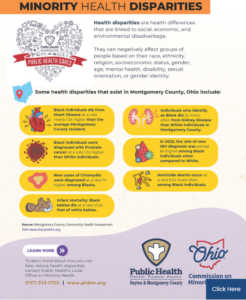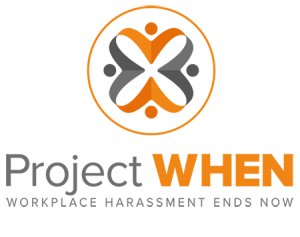Beyond Awareness: How LOMH Uses Communication to Drive Behavioral Change in Minority Health
 The Dayton & Montgomery County Local Office on Minority Health (LOMH) was established to combat health disparities and inequities among minoritized populations in the region. Funded by a grant from the Ohio Commission on Minority Health, in collaboration with Public Health Dayton & Montgomery County (PHDMC), LOMH plays a critical role in promoting health equity. A key driver of its success is its strategic communication approach, which ensures that health information is effectively disseminated, culturally appropriate, and accessible to all communities in the Miami Valley.
The Dayton & Montgomery County Local Office on Minority Health (LOMH) was established to combat health disparities and inequities among minoritized populations in the region. Funded by a grant from the Ohio Commission on Minority Health, in collaboration with Public Health Dayton & Montgomery County (PHDMC), LOMH plays a critical role in promoting health equity. A key driver of its success is its strategic communication approach, which ensures that health information is effectively disseminated, culturally appropriate, and accessible to all communities in the Miami Valley.
Through targeted messaging, community partnerships, and dynamic outreach efforts, LOMH has leveraged communication as a transformative tool to engage minoritized populations, empower them with health knowledge, and foster behavioral change. This case study explores how LOMH’s communication strategies are pivotal in advancing health equity.
The Initiative: Local Office on Minority Health (LOMH)
LOMH’s mission is to provide leadership in reducing and eliminating disparities in the health status of minoritized populations within Dayton and Montgomery County. The vision is to achieve health equity for these communities by focusing on targeted interventions, strategic partnerships, and impactful community engagement, all underpinned by effective communication.
LOMH specifically serves the following racial and ethnic groups:
- Asian or Pacific Islander
- Black or African American
- Hispanic/Latino
- Native American or Indigenous
Key Health Focus Areas
LOMH’s efforts are concentrated on addressing some of the most pressing health concerns affecting minority populations:
- Cancer
- Cardiovascular Disease
- Diabetes
- Infant Mortality
- Lupus
- Substance Abuse
- Violence
Core Competencies for Advancing Health Equity Through Communication
LOMH operates based on four essential competencies that guide its work in addressing health disparities. Communication is integrated into each competency, ensuring that messages are tailored, accessible, and impactful.
- Monitoring Health Status & Data-Driven Messaging
- LOMH collects and analyzes health data to identify disparities and develop evidence-based health campaigns.
- Data storytelling is used to translate statistics into compelling narratives that resonate with community members and policymakers.
- Public health reports are disseminated through multiple channels, including digital media, print materials, and community meetings, to ensure transparency and accessibility.
- Informing, Educating, and Empowering Communities
- LOMH creates culturally competent health education materials tailored to the linguistic and literacy levels of different communities.
- Health promotion campaigns use relatable storytelling and testimonials to increase engagement and trust.
- Social media, community radio, and in-person workshops are leveraged to reach diverse audiences and ensure widespread message penetration.
- Mobilizing Community Partnerships & Grassroots Advocacy
- LOMH collaborates with trusted community organizations, faith-based institutions, and local media to amplify health messages.
- Community ambassadors are trained to serve as messengers, reinforcing health education through peer-to-peer communication.
- Strategic media partnerships help place public health messaging in newspapers, TV segments, and local radio programs that resonate with minority audiences.
- Developing Policies and Plans with Communication at the Forefront
- LOMH engages policymakers through evidence-backed advocacy, ensuring that health equity remains a legislative priority.
- Town halls and community forums provide platforms for residents to voice concerns and influence health policies.
- Communication frameworks are developed to guide crisis response efforts, ensuring timely and accurate information dissemination during public health emergencies.
Strategic Communication Initiatives and Community Engagement
LOMH actively engages the community through various outreach initiatives, ensuring that health messages are clear, relatable, and actionable. One of the most impactful annual efforts is National Minority Health Month in April, which includes the Greater Dayton Minority Health Month EXPO. This free event leverages strategic communication to:
- Deliver health education through engaging workshops and interactive sessions.
- Utilize digital and traditional media to promote wellness initiatives and encourage participation.
- Offer bilingual resources to ensure accessibility for non-English-speaking communities.
- Use testimonials and success stories to highlight real-life health transformations, fostering trust and credibility.
Communication Strategies that Strengthen LOMH’s Impact
1. Culturally Tailored Health Messaging
Why It Worked:
- Materials were designed to reflect the cultural values and beliefs of target communities, increasing engagement.
- Language accessibility ensured that non-English-speaking residents received vital health information.
- Health narratives focused on lived experiences, making messages more relatable and actionable.
Lessons for Other Programs:
- Use storytelling to personalize health education and enhance message retention.
- Translate materials into multiple languages to break down communication barriers.
2. Community-Driven Media Outreach
Why It Worked:
- LOMH partnered with ethnic media outlets, community radio stations, and social media influencers to amplify health messages.
- Leveraging local trusted voices ensured higher credibility and acceptance of health information.
- Video testimonials and visual storytelling helped simplify complex health topics.
Lessons for Other Programs:
- Identify media channels that best reach the target audience.
- Utilize multimedia formats (videos, infographics, podcasts) to engage diverse learning preferences.
3. Interactive Digital and In-Person Communication Strategies
Why It Worked:
- Engaging social media campaigns provided real-time interaction with the community.
- Community health forums and town halls allowed for two-way communication, ensuring that concerns were addressed promptly.
- Virtual workshops and webinars expanded the reach of health education efforts beyond physical events.
Lessons for Other Programs:
- Use a mix of digital and in-person strategies to maximize outreach.
- Encourage dialogue and feedback to continuously improve communication effectiveness.
Results and Impact of Strategic Communication
The integration of communication into LOMH’s health initiatives has led to measurable improvements:
- Increased awareness of preventive care and screenings, leading to higher participation in health programs.
- Greater trust in public health initiatives, as evidenced by increased engagement in community events and resource utilization.
- Stronger policy support for minority health efforts, driven by effective advocacy and storytelling.
Key Takeaways for Public Health Communication Strategies
- Cultural Relevance Matters
- Tailor messages to reflect the values, traditions, and languages of target populations.
- Community-Led Communication is Powerful
- Engage trusted local voices to disseminate health information effectively.
- Multichannel Strategies Enhance Reach
- Use a combination of print, digital, and in-person channels to ensure broad message penetration.
- Feedback Loops Strengthen Impact
- Gather input from community members to continuously refine messaging and outreach efforts.
Conclusion: Communication as the Catalyst for Health Equity
The Dayton & Montgomery County Local Office on Minority Health has demonstrated that strategic communication is not just an auxiliary tool but a fundamental pillar in advancing health equity. By integrating culturally competent messaging, leveraging community partnerships, and using diverse media platforms, LOMH has successfully empowered Southwest Ohio minoritized populations with the knowledge and resources needed to lead healthier lives.
For public health professionals, policymakers, and advocates, LOMH serves as a model for using communication as a powerful instrument for social change. With continued innovation in messaging and outreach, Dayton and Montgomery County can remain at the forefront of inclusive and effective health equity initiatives.
Ready to Elevate Your Agency’s Public Communication?
We understand the unique challenges state and local government agencies face—from complex issues to diverse community needs. Our comprehensive approach can help you transform the way you connect with constituents, improve transparency, and highlight the valuable work your agency does every day.
Interested in learning more? Reach out to us today for a consultation. We’d love to discuss how our services can support your goals and help you build lasting trust with the communities you serve.





